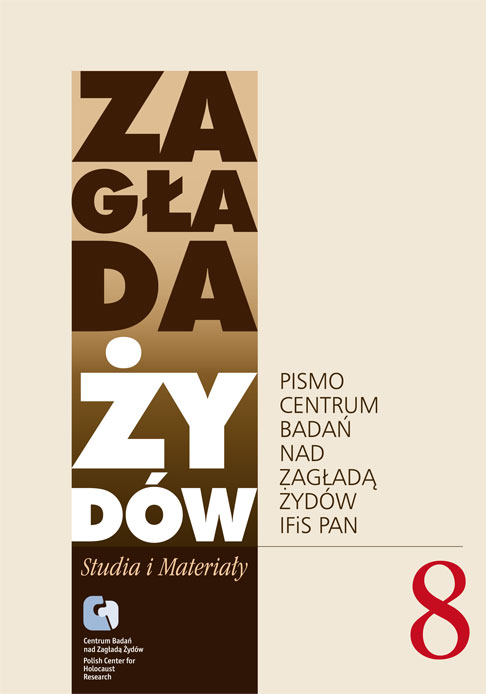Kitsch Affective Remembrance. Władysław Strzemiński’s “To My Jewish Friends”
Zagłada Żydów. Studia i Materiały, No. 8 (2012), Pages: 188-213
Submission Date: 2020-10-28Publication Date: 2012-12-02
 https://doi.org/10.32927/ZZSiM.632
https://doi.org/10.32927/ZZSiM.632
Abstract
Władysław Strzemiński’s “Moim Przyjaciołom Żydom” (To My Jewish Friends) consists of ten collages. It was created right after World War II. Strzemiński did not date or sign the works. His works are collages of drawings, photos and expressive inscriptions. The interpretation proposed in the article bases on an attempt to identify the visual material and to analyze the relations between the text, drawing and photograph and on analyzing them in the political context of Poland in the late 1940s. All photographs Strzemiński used have a documental character. But they differ in the perspective from which they were taken. I would like to ask the following research questions. What can we see in the photos? Who took them and from what perspective? What is the connection between the photographer, the photographed and the viewer? In what way does Strzemiński’s cycle problematize the notion of the observer? In the article I try to metonymically read Strzemiński’s collages taking into account their materiality, the chain of meanings they create and the loops of gazes in the photos and their trajectories. I simultaneously determine the function of the “To My Jewish Friends” cycle in the context of the historical events taking place at that time (e.g. the Nazi war criminals’ trials or the Polish debates on Holocaust memory) while treating the collages not only as a testimony but also as a call for testimony addressed to the future. I also prove that the category of an affect (especially guilt and shame) is useful in the analysis of Strzemiński’s cycle and that in fact the works base on affectiveness and that they transmit specific affects. I ask what affects are the basis for Strzemiński’s cycle and what affects arise during their viewing. I reflect on their critical potential, the possibility to deal with them and the connection with memory and remembrance. My analysis reveals the category of “affective remembrance” of the Holocaust, which opens the present and the past to the horizon of hope and subject/political change.
Keywords
Holocaust , art after 1945 , Władysław Strzemiński , Litzmannstadt Ghetto , affect , guilt , shame , testimony , memory
License
Copyright (c) 2012 Author&"Holocaust Studies and Materials"

This work is licensed under a Creative Commons Attribution 4.0 International License.
https://creativecommons.org/licenses/by/4.0
The journal is published under the Diamond Open Access Standard, CC-BY-4.0 Deed - Attribution 4.0 International - Creative Commons
Most read articles by the same author(s)
- Luiza Nader, Polish Bystanders to the Holocaust. Study into Examples from the Scope of Visual Arts – Preliminary Remarks , Zagłada Żydów. Studia i Materiały: No. 14 (2018)
Similar Articles
- Nawojka Cieślińska-Lobkowicz, Habent Sua Fata Libelli. Occupation-period art market in Warsaw and Jewish property , Zagłada Żydów. Studia i Materiały: No. 10 (2014)
- Jacek Leociak, Understanding the Holocaust. A Task for Generations , Zagłada Żydów. Studia i Materiały: 2008: Holocaust Studies and Materials
- Marta Duch-Dyngosz, In Search of Local Memory of the Holocaust. The Case of Commemoration of Jewish Communities in Smaller Towns in Contemporary Poland , Zagłada Żydów. Studia i Materiały: No. 17 (2021)
- Jacek Leociak, Marta Tomczok, Affective Holocaust Kitsch – Introduction , Zagłada Żydów. Studia i Materiały: No. 17 (2021)
- Nawojka Cieślińska-Lobkowicz, Death of the Antiquarian on Chłodna Street , Zagłada Żydów. Studia i Materiały: No. 12 (2016)
- Dan Michman, Dutch Society and the Jewish Fate: A Puzzling Record , Zagłada Żydów. Studia i Materiały: No. 12 (2016)
- Luiza Nader, Polish Bystanders to the Holocaust. Study into Examples from the Scope of Visual Arts – Preliminary Remarks , Zagłada Żydów. Studia i Materiały: No. 14 (2018)
- Sylweriusz B. Królak, Strolling in the Ghetto. Experience of the Space of the Łódź and Warsaw Ghettoes from a Pedestrian’s Perspective , Zagłada Żydów. Studia i Materiały: No. 16 (2020)
- Jacek Leociak, Anniversaries of the Warsaw Ghetto Uprising in public discourse (with special reference to the years 1943–1944, 1968 and 2023) , Zagłada Żydów. Studia i Materiały: No. 19 (2023)
- Nawojka Cieślińska-Lobkowicz, Predator. The Looting Activity of Pieter Nicolaas Menten (1899–1987) , Zagłada Żydów. Studia i Materiały: No. Holocaust Studies and Materials (2017)
1 2 3 4 5 6 7 8 9 10 11 12 13 14 15 16 17 18 19 20 21 22 23 24 25 26 27 28 29 30 31 32 33 34 35 36 37 38 39 40 41 42 43 44 45 46 47 48 49 50 > >>
You may also start an advanced similarity search for this article.
 English
English
 Język Polski
Język Polski



 https://orcid.org/0000-0002-9987-4992
https://orcid.org/0000-0002-9987-4992

